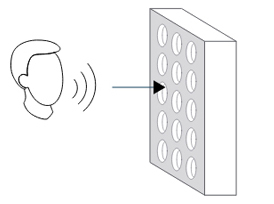We develop the products
that improve
the room acoustics
Deeper learning of the acoustics issues and developing the products that are passive in terms of the acoustics enables to design the spaces that improve the room acoustics not only in the offices, but also in the public and HoReCa spaces.

20 dB
200 μPa

60 dB
20 000 μPa

80 dB
200 000 μPa

120 dB
20 000 000 μPa
Source: FIS, The guide to office acoustic
ISBN 978-0-9565341-1-8, 2015

Sound propagation
Sound
Sound – is an auditory impression,
caused, by the acoustic wave propagated
in the solid body, fluid or gas.
Interior acoustics
Interior acoustics specifies how sound
behaves in the room.
The movement, attenuation, absorption,
sound reflection are the most important acoustic aspects.
Basic acoustic phenomena

Reflection

Absorption

Dispersion

Attenuation
Acoustic products of Bejot
have the sound absorption certificates
specified on the basis of ISO 354 standard.
Facts

How does noise affect us?
67%
A decrease
in work accuracy
>40%
of the employees
are not able to perform
their work fully
30%
A decrease
in employee’s productivity
Source:
Evidence Space, Improving employee productivity
by reducing noise, British Gypsum, Coventry, 2015
64%
of employees
feels discomfort
due to a noise caused
by the conversations and phones
Costs of the poor acoustics
5 000 €
A monthly cost of the highly qualified employee borne by the employer
30%
A decrease in productivity connected with the poor acoustic conditions
1 500 €
losses / month
18 000 €
1 500 € x
12 months ≈
360 000 €
20 employees x
18 000 € ≈

What good acoustics can change?

It increases effectiveness
and accuracy

Reduces stress

Reduces an elevated blood pressure
and heart rate

Improves concentration

Decreases discomfort caused
by the conversations.

Source:
Evidence Space, Improving employee productivity by reducing noise,
British Gypsum, Coventry, 2015
Cowan, The Effect of sound people, Wiley, Chichester, 2016, 93–95
Enjoy the silence

Ask about a purpose of the office and a nature of the work of the persons who stay in it.
For greater efficiency, use a ceiling and two adjacent, perpendicular walls (one from a pair of the horizontal ones).
Remember about insulating from the noise sources – the higher the screen, the better. A tightness of the partition is of importance, too.
A closer location of the acoustic products in respect of a sound source will enable to absorb a greater amount of the sound.
Fill as much space as possible with the soft elements, e.g. upholstered furniture, floor covering.
A proper work organisation, e.g. a separation of the silence zones, communication and a team work will help improve the acoustic conditions.








 EN
EN
 PL
PL
 DE
DE
 FR
FR



